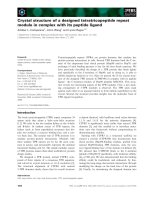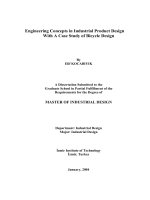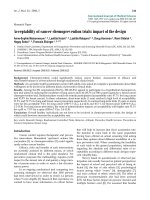Project of foundation design
Bạn đang xem bản rút gọn của tài liệu. Xem và tải ngay bản đầy đủ của tài liệu tại đây (5.21 MB, 100 trang )
<span class="text_page_counter">Trang 1</span><div class="page_container" data-page="1">
<b>HO CHI MINH CITY</b>
<b>UNIVERSITY OF TECHNOLOGY AND EDUCATION</b>
<b>PROJECT OF FOUNDATION DESIGN</b>
INSTRUCTOR: DR. NGUYEN VAN CHUNG
STUDENT ID: 20149103
HKI 2023-2024
</div><span class="text_page_counter">Trang 2</span><div class="page_container" data-page="2"><i><b>Project of Foundation DesignInstructor: Dr Nguyen Van Chung</b></i>
<b>TABLE CONTENTS</b>
CHAPTER I: SOIL INVESTIGATION...4
1. Soil investigation formular and definition...4
2. Choose the depth of the foundation...44
3. Determine size of foundation...45
4. Calculation of reinforcement...53
CHAPTER III: STRIP FOUNDATION DESIGN...57
1. Calculation data...57
2. Calculation strip foundation...59
3. Check size of foundation...62
4. Check stability condition...63
5. Check the anti-slip forces condition...64
6. Check condition strength...65
7. Check settlement condition...66
<b> Nguyen Trong Nhan - 20149103</b>
</div><span class="text_page_counter">Trang 3</span><div class="page_container" data-page="3"><i><b>Project of Foundation DesignInstructor: Dr Nguyen Van Chung</b></i>
8. Check punching shear...69
9. Internal calculation of the strip foundation...70
10.Calculate the reinforcement...73
11. Calculate the reinforcement in foundation slab...74
CHAPTER IV: PILE FOUNDATION DESIGN...78
1. Calculation data...80
2. Calculation pile foundation...84
3. Choose size of foundation...84
4. Determine the load capacity of the pile...86
5. Determine the number of pile and arrangement the pile...92
6. Check the bearing capacity of pile...93
7. Check the load capacity of the pile...94
8. Check the stability and settlement of the pile foundation...95
9. Check the settlement condition of the foundation...97
10. Design pile cap...99
11. Calculation reinforcement for pile cap
</div><span class="text_page_counter">Trang 4</span><div class="page_container" data-page="4"><i><b>Project of Foundation DesignInstructor: Dr Nguyen Van Chung</b></i>
<b>CHAPTER I: SOIL INVESTIGATION1. Soil investigation formular and definition: </b>
<b>1.1. Statistical theory:</b>
- Geological survey records for foundation design with a large number of boreholes and number of soil samples in a large soil layer. The problem is these soil layers we have to choose is the target to represent the background.
- Initially, when drilling, sampling was based on the observation of color change, the degree of grain that we divided each layer of soil.
- According to TCVN 9362-2012, it is called a geotechnical layer when the set of values having its mechanical properties must have a sufficiently small coefficient of variation . Therefore, we must exclude the samples with data disparate with large mean values for a geological unit.
- So geological statistics is a very important job in the calculation of the foundation.
<b>1.2. Division of geological units1.2.1. Coefficient of Variation </b>
We rely on coefficient of variation unary division: - The coefficient of variation v is determined by the formula:
<b> Nguyen Trong Nhan - 20149103</b>
</div><span class="text_page_counter">Trang 5</span><div class="page_container" data-page="5"><i><b>Project of Foundation DesignInstructor: Dr Nguyen Van Chung</b></i>
- In there:
Average value of a feature: Mean square deviation: The mean square deviation:
When checking to eliminate gross errors for double criteria such as adhesion
as follows:
is the eigenvalue of eigenvalues in the same soil layer. n: number of test samples of quantity A in the same soil layer.
<b>1.3. Rule for the exclusion of raw errors</b>
- In the sample set of a soil layer with coefficient of variation [], the opposite is achieved then we have to exclude data with large or small errors.
- In which []: the largest coefficient of variation, look up Table 1 depending on each
<b> Nguyen Trong Nhan - 20149103</b>
</div><span class="text_page_counter">Trang 6</span><div class="page_container" data-page="6"><i><b>Project of Foundation DesignInstructor: Dr Nguyen Van Chung</b></i>
following formula | - A | ≥ Vσ . In which deviation is estimated:<small>�cm</small>
<b>1.4. Standard value of soil characteristics1.4.1. Standard values of single indicators</b>
- Standard values of all single parameters (physical parameters such as humidity, bulk weight volume, plasticity index, viscosity, ... and mechanical parameters such as total
<b> Nguyen Trong Nhan - 20149103</b>
</div><span class="text_page_counter">Trang 7</span><div class="page_container" data-page="7"><i><b>Project of Foundation DesignInstructor: Dr Nguyen Van Chung</b></i>
strain modulus, compressive strength, …) is the average of the individual test results Ā after, excluding gross errors.
<b>1.4.2. Standard value of dual indicators:</b>
- The standard values of the dual criteria of unit adhesive force (c) and internal friction angle () are made according to the method of least squares of the linear relationship of normal stress and stress. the extreme contact of the equivalent shear<small>ii</small>
experiments:
- The standard unit adhesive force c and the friction angle in the standard <small>tctc </small>are determined by the following formula:
- If the above formula can be calculated c < 0, then choose c = 0 and recalculate<small>tctc</small>
according to the formula:
<b>1.5. Calculating soil characteristics1.5.1. Calculation value of single indicators</b>
- In order to improve the safety for the stability of the load-bearing foundation, some stability calculations of the foundation are carried out with the calculation characteristics.
- The calculated value of single criteria is determined by the following formula:
In there:
A<small>tc</small> is the standard value of the features under consideration. The factor of safety on soil is determined by the formula: - The accuracy index is determined by the formula:
In there:
t<small>α</small> is the coefficient that depends on the confidence probability Dynamic coefficient is determined according to item 1.2.1
<b> Nguyen Trong Nhan - 20149103</b>
</div><span class="text_page_counter">Trang 8</span><div class="page_container" data-page="8"><i><b>Project of Foundation DesignInstructor: Dr Nguyen Van Chung</b></i>
When calculating the background by intensity (TTGH I), α = 0.95 When calculating the background according to strain (TTGH II), α = 0.85 - The minimum number of a certain criterion experiment with each engineering geological unit needs to be ensured is 6.
- If within the scope of engineering geology unit there are less than 6 samples, the calculated values of their criteria are calculated according to the method of minimum average and average maximum:
- The choice of calculation according to one of the two formulas depends on the criteria that increase the safety of the works.
<b>1.5.2. Calculation value of double indicators</b>
- The calculated value of the double criteria is determined according to the following formula:
In there:
A<small>tc</small> is the standard value of the features under consideration. - For double criteria such as: stick force c and coefficient of friction tg.
We have the formula: = t ν<small>α</small>
The coefficient of variation is determined according to the following formulas: and
The mean square deviation is determined according to the following formula: When calculating the background by intensity (TTGH I), α = 0.95
When calculating the background according to strain (TTGH II), α = 0.85 Note:
To find the standard and calculated values of c and , it is necessary to determine not less than 6 values of for each value of normal pressure .
When finding the calculated value c, uses the total number of experiments to do n.
Degree of freedom
<b> Nguyen Trong Nhan - 20149103</b>
</div><span class="text_page_counter">Trang 9</span><div class="page_container" data-page="9"><i><b>Project of Foundation DesignInstructor: Dr Nguyen Van Chung</b></i>
- The computed features according to TTGH I and TTGH II have values in the range:
- Depending on the specific design case, we take the sign (+) or the sign (-) to ensure more safety.
- When calculating the background according to the intensity and stability, we take the calculated characteristics according to TTGH I (in the larger range = 0.95).
<b> Nguyen Trong Nhan - 20149103</b>
</div><span class="text_page_counter">Trang 10</span><div class="page_container" data-page="10"><i><b>Project of Foundation DesignInstructor: Dr Nguyen Van Chung</b></i>
- When calculating the background according to the deformation, we take the calculated characteristics according to TTGH II (in the range less than = 0.85).
- Soil properties: Clay mixed Lateric gravel, yellow brown – pink brown-red brown, hard plastic state.
</div><span class="text_page_counter">Trang 11</span><div class="page_container" data-page="11"><i><b>Project of Foundation DesignInstructor: Dr Nguyen Van Chung</b></i>
<b>a) Determine the standard value:Empty factor by load class</b>
</div><span class="text_page_counter">Trang 12</span><div class="page_container" data-page="12"><i><b>Project of Foundation DesignInstructor: Dr Nguyen Van Chung</b></i>
<b>The above sample set is selected</b>
<b>Empty factor by load class</b>
No <sup>Drill</sup><sub>hole</sub> <sup>Model</sup>numbe
<b> Nguyen Trong Nhan - 20149103</b>
</div><span class="text_page_counter">Trang 13</span><div class="page_container" data-page="13"><i><b>Project of Foundation DesignInstructor: Dr Nguyen Van Chung</b></i>
</div><span class="text_page_counter">Trang 14</span><div class="page_container" data-page="14"><i><b>Project of Foundation DesignInstructor: Dr Nguyen Van Chung</b></i>
<b>b) Determine the standard value:</b>
()
<b>Empty factor by load class</b>
No <sup>Drill</sup><sub>hole</sub> <sub>number</sub><sup>Model</sup> Depth
Empty factor e corresponding to the load class
</div><span class="text_page_counter">Trang 15</span><div class="page_container" data-page="15"><i><b>Project of Foundation DesignInstructor: Dr Nguyen Van Chung</b></i>
<b> Nguyen Trong Nhan - 20149103</b>
</div><span class="text_page_counter">Trang 16</span><div class="page_container" data-page="16"><i><b>Project of Foundation DesignInstructor: Dr Nguyen Van Chung</b></i>
<b>=> So all of the samples in layer 4 are selectedb) Determine the standard value:</b>
()
<b>c) Determine the value according to limit state I:</b>
With limit state I then the confidence probability . Look up the table we get
<b>d) Determine the value according to limit state II:</b>
With the limit state II then the confidence probability . Look up the table we get
<b>Empty factor by load class</b>
<b> Nguyen Trong Nhan - 20149103</b>
</div><span class="text_page_counter">Trang 17</span><div class="page_container" data-page="17"><i><b>Project of Foundation DesignInstructor: Dr Nguyen Van Chung</b></i>
Empty factor e corresponding to the load class
<b>Friction angle and stick force</b>
</div><span class="text_page_counter">Trang 18</span><div class="page_container" data-page="18"><i><b>Project of Foundation DesignInstructor: Dr Nguyen Van Chung</b></i>
- Soil properties: Clay and Laterite gravel grit, white gray - red brown - yellow brown, hard and soft plastic state.
</div><span class="text_page_counter">Trang 19</span><div class="page_container" data-page="19"><i><b>Project of Foundation DesignInstructor: Dr Nguyen Van Chung</b></i>
- Soil properties: Heavy phase clay, yellow brown - white grey, hard and soft plastic
- Soil properties: Heavy phase clay - clay mixed sand, yellow-brown - white grey, hard plastic state.
Soil properties: Heavy phase clay clay mixed sand, yellow brown – pink brown -white grey, hard plastic state.
- Soil properties: Mixed sand, yellow brown - pink brown white grey.
<b>3.1. Geological statistics of soil layer 1:3.1.1. Single target statistics:</b>
Bulk density:
<b> Nguyen Trong Nhan - 20149103</b>
</div><span class="text_page_counter">Trang 20</span><div class="page_container" data-page="20"><i><b>Project of Foundation DesignInstructor: Dr Nguyen Van Chung</b></i>
</div><span class="text_page_counter">Trang 21</span><div class="page_container" data-page="21"><i><b>Project of Foundation DesignInstructor: Dr Nguyen Van Chung</b></i>
<b>=> So the sample set is selected</b>
<b>=> So the sample set is selected</b>
<b>=> So the sample set is selected</b>
<b>=> So the sample set is selected</b>
<b>=> So the sample set is selected</b>
No. <sub>number</sub><sup>Model</sup> Depth <sup>Empty factor e corresponding to the load class P (</sup><sub>(0-25)</sub> <sub>(25-50)</sub> <sub>(50-100)</sub> <sub>(100-200)</sub>
<b>3.1.2. Empty factor by load class e:3.1.3. Multiple target statistics:</b>
</div><span class="text_page_counter">Trang 22</span><div class="page_container" data-page="22"><i><b>Project of Foundation DesignInstructor: Dr Nguyen Van Chung</b></i>
<b>a) Check statistics:</b>
<b>= > Accepted the sample test.</b>
<b>b) Determine the value according to limit state:</b>
0.01387 =>
<b>3.2. Geological statistics of soil layer 2:3.2.1. Single target statistics:</b>
</div><span class="text_page_counter">Trang 23</span><div class="page_container" data-page="23"><i><b>Project of Foundation DesignInstructor: Dr Nguyen Van Chung</b></i>
</div><span class="text_page_counter">Trang 24</span><div class="page_container" data-page="24"><i><b>Project of Foundation DesignInstructor: Dr Nguyen Van Chung</b></i>
<b>=> So the sample set is selected</b>
<b>=> So the sample set is selected</b>
<b>=> So the sample set is selected</b>
<b>=> So the sample set is not selected</b>
<b>=> So the sample set is not selected3.2.2. Empty factor by load class e:</b>
No. <sub>number</sub><sup>Model</sup> Depth <sub>(25-50)</sub><sup>Empty factor e corresponding to the load class P (</sup><sub>(50-100)</sub> <sub>(100-200)</sub> <sub>(200-400)</sub>
</div><span class="text_page_counter">Trang 25</span><div class="page_container" data-page="25"><i><b>Project of Foundation DesignInstructor: Dr Nguyen Van Chung</b></i>
<b>3.2.3. Mutiple target statistics:</b>
<b>= > Accepted the sample test.</b>
<b>b) Determine the value according to limit state:</b>
0.212 =>
<b>3.3. Geological statistics of soil layer 3a:3.3.1. Single target statistics:</b>
</div><span class="text_page_counter">Trang 26</span><div class="page_container" data-page="26"><i><b>Project of Foundation DesignInstructor: Dr Nguyen Van Chung</b></i>
<b>=> So the sample set is selected</b>
<b> Nguyen Trong Nhan - 20149103</b>
</div><span class="text_page_counter">Trang 27</span><div class="page_container" data-page="27"><i><b>Project of Foundation DesignInstructor: Dr Nguyen Van Chung</b></i>
<b>=> So the sample set is selected</b>
<b>=> So the sample set is selected</b>
<b>=> So the sample set is not selected</b>
<b>=> So the sample set is selected</b>
<b>a) Determine the value according to limit state I:</b>
With limit state I then the confidence probability . Look up the table we get
<b>-b) Determine the value according to limit state II:</b>
With the limit state II then the confidence probability . Look up the table we get
</div><span class="text_page_counter">Trang 28</span><div class="page_container" data-page="28"><i><b>Project of Foundation DesignInstructor: Dr Nguyen Van Chung</b></i>
<b>3.3.2. Empty factor by load class e:3.3.3. Multiple target statistics:</b>
<b>3.4. Geological statistics of soil layer 3:3.4.1 Single target statistics:</b>
</div><span class="text_page_counter">Trang 29</span><div class="page_container" data-page="29"><i><b>Project of Foundation DesignInstructor: Dr Nguyen Van Chung</b></i>
</div><span class="text_page_counter">Trang 30</span><div class="page_container" data-page="30"><i><b>Project of Foundation DesignInstructor: Dr Nguyen Van Chung</b></i>
<b>=> So the sample set is selected</b>
<b>=> So the sample set is not selected</b>
<b>=> So the sample set is selected</b>
<b>=> So the sample set is selected</b>
<b>=> So the sample set is not selected</b>
No <sub>number</sub><sup>Model</sup> Depth <sub>(25-50)</sub><sup>Empty factor e corresponding to the load class P (</sup><sub>(50-100)</sub> <sub>(100-200)</sub> <sub>(200-400)</sub>
</div><span class="text_page_counter">Trang 31</span><div class="page_container" data-page="31"><i><b>Project of Foundation DesignInstructor: Dr Nguyen Van Chung</b></i>
<b>3.4.2. Empty factor by load class e:3.4.3. Multiple target statistics:</b>
<b>3.5. Geological statistics of soil layer 4a:3.5.1 Single target statistics:</b>
</div><span class="text_page_counter">Trang 32</span><div class="page_container" data-page="32"><i><b>Project of Foundation DesignInstructor: Dr Nguyen Van Chung</b></i>
<b>=> So the sample set is selected</b>
<b>=> So the sample set is selected</b>
<b> Nguyen Trong Nhan - 20149103</b>
</div><span class="text_page_counter">Trang 33</span><div class="page_container" data-page="33"><i><b>Project of Foundation DesignInstructor: Dr Nguyen Van Chung</b></i>
<b>=> So the sample set is selected</b>
<b>=> So the sample set is not selected</b>
<b>=> So the sample set is not selected</b>
No <sub>number</sub><sup>Model</sup> Depth <sub>(25-50)</sub><sup>Empty factor e corresponding to the load class P (</sup><sub>(50-100)</sub> <sub>(100-200)</sub> <sub>(200-400)</sub>
<b>3.4.2. Empty factor by load class e:3.4.3. Multiple target statistics:</b>
</div><span class="text_page_counter">Trang 34</span><div class="page_container" data-page="34"><i><b>Project of Foundation DesignInstructor: Dr Nguyen Van Chung</b></i>
<b>3.4. Geological statistics of soil layer 3:3.4.1 Single target statistics:</b>
</div><span class="text_page_counter">Trang 48</span><div class="page_container" data-page="48"><i><b>Project of Foundation DesignInstructor: Dr Nguyen Van Chung</b></i>
→ This is satisfied settlement condition.
<b>3.8. Check the anti-slip forces condition:</b>
Slippage force:
<b> Nguyen Trong Nhan - 20149103</b>
</div><span class="text_page_counter">Trang 49</span><div class="page_container" data-page="49"><i><b>Project of Foundation DesignInstructor: Dr Nguyen Van Chung</b></i>
Anti-slip force:
Friction force between the soil and the bottom of the foundation. Active pressure coefficient of layer 3:
Active pressure at depth z:
Passive pressure of the layer 3:
Total active soil pressure:
Total passive soil pressure:
</div><span class="text_page_counter">Trang 50</span><div class="page_container" data-page="50"><i><b>Project of Foundation DesignInstructor: Dr Nguyen Van Chung</b></i>
→ This is satisfied slip condition.
<b>3.9. Check punching shear:</b>
We have
The area of an approximate punching surface (rectangular):
Maximum calculation pressure at the foundation:
Minimum calculation pressure at the foundation:
</div><span class="text_page_counter">Trang 51</span><div class="page_container" data-page="51"><i><b>Project of Foundation DesignInstructor: Dr Nguyen Van Chung</b></i>
Figure 2.3: Punching shear cross-section:
<b>4. Calculation of reinforcement:4.1. Section 1-1: </b>
Figure 2.4: Schematic of reinforcement according to l
The calculation diagram is console beam under trapezoidal load , we convert it to evenly distributed load :
<b> Nguyen Trong Nhan - 20149103</b>
</div><span class="text_page_counter">Trang 52</span><div class="page_container" data-page="52"><i><b>Project of Foundation DesignInstructor: Dr Nguyen Van Chung</b></i>
Moment at the foot of the column :
The area of reinforcement:
Choose with area of a steel bar: Number of steel bar:
→ Choose 12 steel bars Distance between each bar:
<b>4.2. Section 2-2: </b>
Figure 2.5: Schematic of reinforcement according to b
<b> Nguyen Trong Nhan - 20149103</b>
</div><span class="text_page_counter">Trang 53</span><div class="page_container" data-page="53"><i><b>Project of Foundation DesignInstructor: Dr Nguyen Van Chung</b></i>
Moment at the foot of the column :
The area of reinforcement:
Choose with area of a steel bar: Number of steel bar:
→ Choose 10 steel bars Distance between each bar:
→ Choose a= 250 mm → Choose short-edge steel L:
<b> Nguyen Trong Nhan - 20149103</b>
</div><span class="text_page_counter">Trang 54</span><div class="page_container" data-page="54"><i><b>Project of Foundation DesignInstructor: Dr Nguyen Van Chung</b></i>
<b> Nguyen Trong Nhan - 20149103</b>
</div><span class="text_page_counter">Trang 55</span><div class="page_container" data-page="55"><i><b>Project of Foundation DesignInstructor: Dr Nguyen Van Chung</b></i>
<b>CHAPTER 3: STRIP FOUNDATION DESIGN</b>
<b>1.4.Geological cross – section:</b>
<b> Nguyen Trong Nhan - 20149103</b>
</div><span class="text_page_counter">Trang 56</span><div class="page_container" data-page="56"><i><b>Project of Foundation DesignInstructor: Dr Nguyen Van Chung</b></i>
Figure 3.1. Section drill hole
<b>2. Calculation strip foundation</b>
<b>2.1.Choose the depth of the foundation:</b>
The foundation is placed in a layer of soil that is good for construction.
The foundation bottom is at least 0.2 m from the boundary of the layer (soft soil) with the good soil layer
The foundation bottom must be at least 0.5m higher than the groundwater level. Based on geological data, the thickness of the first layer is 8.3m it is very reasonable
<b> Nguyen Trong Nhan - 20149103</b>
</div>








